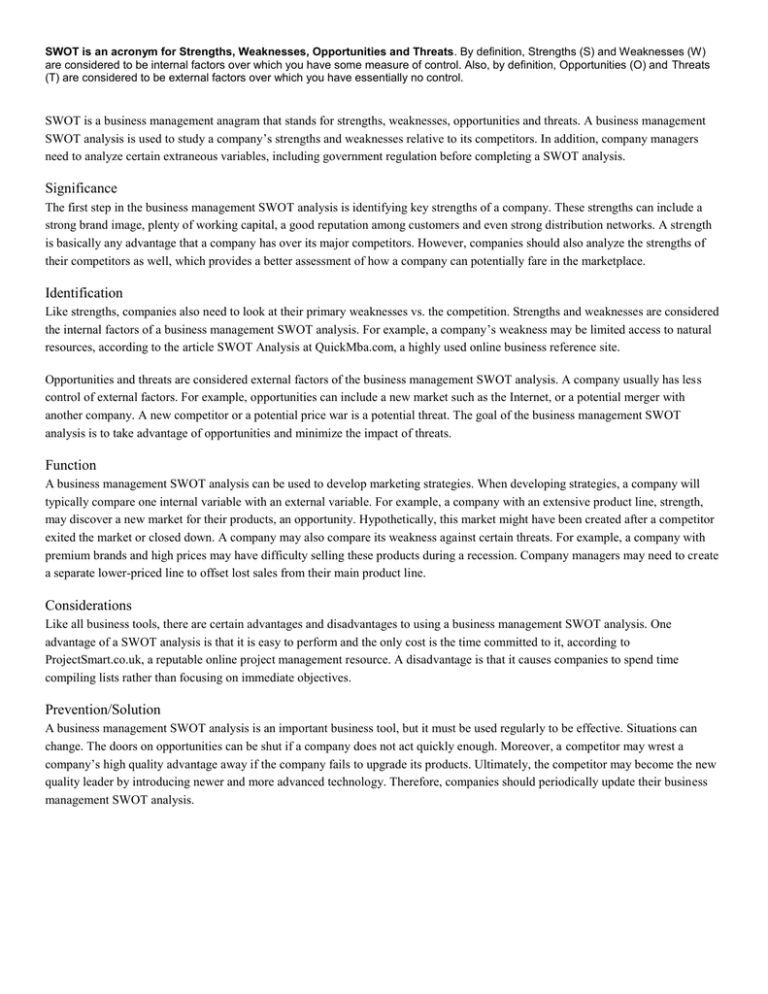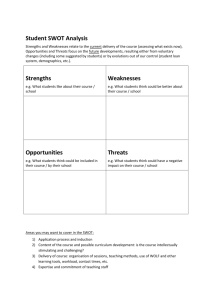SWOT is an acronym for Strengths, Weaknesses, Opportunities and Threats
advertisement

SWOT is an acronym for Strengths, Weaknesses, Opportunities and Threats. By definition, Strengths (S) and Weaknesses (W) are considered to be internal factors over which you have some measure of control. Also, by definition, Opportunities (O) and Threats (T) are considered to be external factors over which you have essentially no control. SWOT is a business management anagram that stands for strengths, weaknesses, opportunities and threats. A business management SWOT analysis is used to study a company’s strengths and weaknesses relative to its competitors. In addition, company managers need to analyze certain extraneous variables, including government regulation before completing a SWOT analysis. Significance The first step in the business management SWOT analysis is identifying key strengths of a company. These strengths can include a strong brand image, plenty of working capital, a good reputation among customers and even strong distribution networks. A strength is basically any advantage that a company has over its major competitors. However, companies should also analyze the strengths of their competitors as well, which provides a better assessment of how a company can potentially fare in the marketplace. Identification Like strengths, companies also need to look at their primary weaknesses vs. the competition. Strengths and weaknesses are considered the internal factors of a business management SWOT analysis. For example, a company’s weakness may be limited access to natural resources, according to the article SWOT Analysis at QuickMba.com, a highly used online business reference site. Opportunities and threats are considered external factors of the business management SWOT analysis. A company usually has less control of external factors. For example, opportunities can include a new market such as the Internet, or a potential merger with another company. A new competitor or a potential price war is a potential threat. The goal of the business management SWOT analysis is to take advantage of opportunities and minimize the impact of threats. Function A business management SWOT analysis can be used to develop marketing strategies. When developing strategies, a company will typically compare one internal variable with an external variable. For example, a company with an extensive product line, strength, may discover a new market for their products, an opportunity. Hypothetically, this market might have been created after a competitor exited the market or closed down. A company may also compare its weakness against certain threats. For example, a company with premium brands and high prices may have difficulty selling these products during a recession. Company managers may need to create a separate lower-priced line to offset lost sales from their main product line. Considerations Like all business tools, there are certain advantages and disadvantages to using a business management SWOT analysis. One advantage of a SWOT analysis is that it is easy to perform and the only cost is the time committed to it, according to ProjectSmart.co.uk, a reputable online project management resource. A disadvantage is that it causes companies to spend time compiling lists rather than focusing on immediate objectives. Prevention/Solution A business management SWOT analysis is an important business tool, but it must be used regularly to be effective. Situations can change. The doors on opportunities can be shut if a company does not act quickly enough. Moreover, a competitor may wrest a company’s high quality advantage away if the company fails to upgrade its products. Ultimately, the competitor may become the new quality leader by introducing newer and more advanced technology. Therefore, companies should periodically update their business management SWOT analysis.




